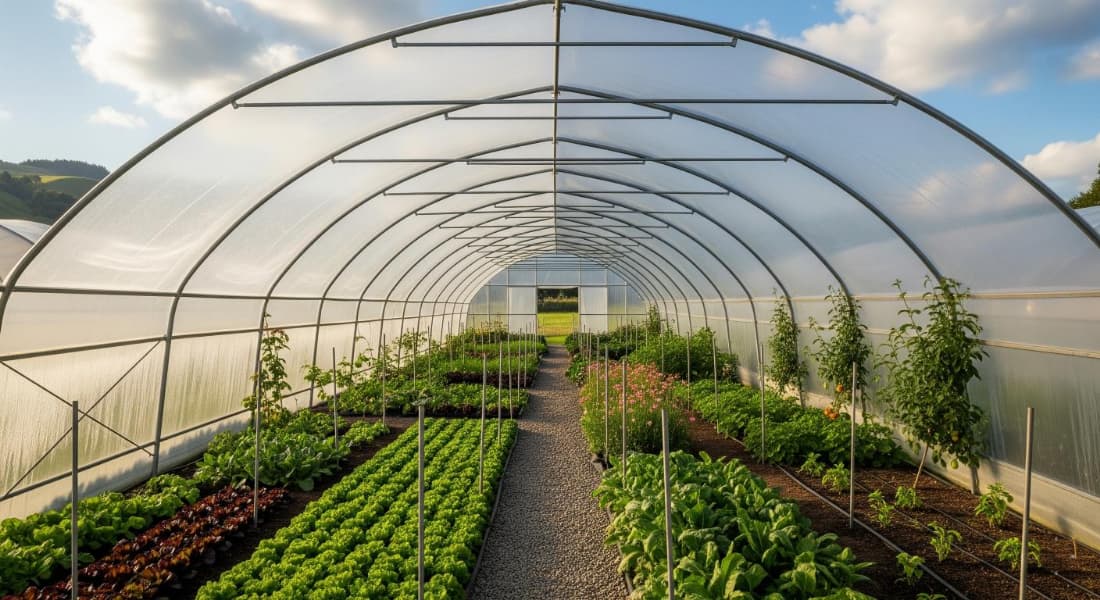Greenhouse Films | Durable Plant Protection
High-quality greenhouse films that protect plants and improve crop productivity efficiently.
Table of Contents

what are Greenhouse films? Greenhouse films are one of the essential tools in modern agriculture, allowing farmers to control the growing environment of plants precisely. These films regulate temperature, humidity, and light inside the greenhouse, ensuring higher-quality and better-performing crops. Using high-quality greenhouse films protects plants from cold, heat, rain, and sudden weather changes, while also extending the lifespan of the greenhouse. In addition, greenhouse films reduce the waste of resources such as water and energy, helping to save costs and improve overall production efficiency.
Features and Benefits of Greenhouse Films
Temperature and Humidity Control
Greenhouse films help maintain uniform temperature and humidity levels inside the greenhouse, creating ideal conditions for plant growth. Consistent climate conditions reduce plant stress and promote even growth, resulting in high-quality produce. Farmers can manage the internal climate even during extreme weather, minimizing crop damage risks. Proper humidity control prevents fungal diseases and mold, ensuring the final product’s quality. This feature is especially important for sensitive crops and export-oriented greenhouses.
Transparency and Light Transmission
Greenhouse films must be transparent to allow sufficient light for photosynthesis. Adequate light accelerates plant growth and improves both yield and quality. High-transparency films distribute light evenly, reducing shadowed areas. This is critical for light-sensitive crops and short growth cycle products, significantly increasing greenhouse productivity.
UV Resistance and Environmental Durability
Greenhouse films are made with UV-resistant materials to ensure long lifespan. This durability protects against direct sunlight, rain, wind, and other harsh conditions, reducing the need for frequent replacements. UV-resistant films prevent plant damage and maintain product quality, ensuring year-round greenhouse productivity. Additionally, environmental durability lowers maintenance costs and increases overall efficiency.

Types of Greenhouse Films
Standard Greenhouse Film
Standard greenhouse films are the most economical option, suitable for small to medium-sized greenhouses. In temperate regions, standard films meet basic plant protection needs and ensure healthy growth. However, in areas with strong sunlight or high temperature fluctuations, their lifespan is shorter, requiring more frequent replacement. Easy and quick installation makes them ideal for farmers with limited budgets or temporary greenhouses.
UV-Protected Film for Tropical Areas
UV-protected films are designed for sunny and tropical regions, offering high resistance to direct sunlight. Their UV protection extends the greenhouse cover’s lifespan and better safeguards plants. These films maintain crop quality and reduce the need for frequent replacements, making them ideal for sensitive crops and export-oriented greenhouses.
Anti-Drip Film
Anti-drip films prevent water droplets from forming on plants, reducing fungal and mold risks. They help maintain controlled humidity, promoting healthier plant growth. In humid regions or greenhouses with misting systems, anti-drip films significantly improve the final product quality and reduce waste caused by excessive moisture.
Thermic Film
Thermic films are designed to retain heat during cold seasons, reducing heat loss. They stabilize the internal greenhouse temperature, creating an optimal environment for plant growth. Thermic films increase yield and quality, reduce energy consumption, and enhance efficiency. They are the best option for cold climates and advanced greenhouses requiring precise temperature management.

Applications of Greenhouse Films in Agriculture
Improving Crop Quality and Yield
Greenhouse films support healthy plant growth and produce high-quality crops. They ensure uniform growth despite temperature and humidity fluctuations, increasing overall production. Greenhouses equipped with appropriate films achieve higher yields than those without coverage, optimizing farmers’ investments. For crops like vegetables, cucumbers, and strawberries, greenhouse films can enhance performance and quality by 30–50%.
Water and Fertilizer Efficiency
Greenhouse films reduce water evaporation and optimize water use. Nutrients remain in the soil, promoting more effective plant growth. This economic benefit lowers agricultural costs and improves production sustainability. Reducing water and fertilizer use also minimizes environmental pollution and preserves natural resources.
Protection Against Cold and Heat
Greenhouse films protect crops from sudden frost, heat, and direct sunlight. This protection reduces product damage and increases yield. High-quality films keep crops safe even during harsh seasons, securing farmers’ investments. This feature is crucial for export-oriented greenhouses and sensitive crops.

Key Considerations for Choosing Greenhouse Films
Thickness and Size
The thickness of the film should match the crop type, plant weight, and greenhouse conditions. Thicker films offer better resistance to wind, rain, and snow, reducing tear risk. Correct dimensions ensure full coverage, preventing heat and light loss, which is vital for uniform plant growth. Choosing inappropriate thickness can damage sensitive crops, shorten film life, and increase maintenance costs. Proper thickness also improves energy efficiency and reduces heating expenses.
Climate Conditions
Selecting the right film depends on the region’s climate. UV-protected films are essential in sunny and hot areas to prevent crop damage and extend film life. Thermic films help retain heat in cold regions, preventing frost and energy waste. Understanding humidity, wind, and daily temperature changes allows farmers to select the optimal film and minimize potential losses. Matching the film type to environmental conditions reduces the need for additional equipment and maintenance.
Lifespan and Warranty
Long-lasting films with valid warranties significantly reduce maintenance and replacement costs. High-quality films are made of UV-resistant, tear-resistant, heat-resistant, and cold-resistant materials for long-term use. Purchasing from reputable manufacturers ensures durability, reliable performance, and investment security. Warranties give farmers confidence and allow precise planning for growing seasons. Overall, lifespan and warranty make film selection a smart and economical investment.
Crop Type Compatibility
The plant type and sensitivity to light, humidity, and temperature influence film choice. Cold-sensitive plants require thermic films, while light-sensitive crops grow better under UV-protected films. Wrong selection can reduce crop quality, slow growth, and cause economic loss. Farmers should consider plant type, growth stage, and specific requirements to choose the most suitable film, enhancing yield, reducing waste, and maintaining product quality.
Proper Installation and Maintenance
Installation directly impacts film performance. Correct installation ensures full coverage, preventing wind, rain, and pest intrusion. Proper maintenance and periodic inspections prevent tearing and degradation, extending film life. Using sturdy fasteners and supports guarantees final coverage quality and crop protection. Training staff in correct installation and maintenance minimizes errors and maximizes greenhouse productivity.

Purchasing Greenhouse Films from Tadbir Polymer Mandegar
Guaranteed Quality and Competitive Price
Tadbir Polymer Mandegar greenhouse films are produced according to international standards, ensuring consistently high-quality products. Competitive pricing makes them the top choice for professional farmers and greenhouse operators. Guaranteed quality reduces maintenance costs, increases long-term greenhouse efficiency, and saves resources and energy.

Custom Sizes and Thicknesses
Producing films in various sizes and thicknesses allows precise adaptation to any greenhouse or crop type, meeting diverse farmer needs. This flexibility minimizes material waste, optimizes resource use, and maximizes greenhouse performance. Farmers can order exact dimensions to provide optimal growth conditions and prevent potential crop damage from unsuitable films.
Expert Consultation for the Best Choice
Tadbir Polymer Mandegar offers expert consultation to select the most suitable film type. Our specialists consider crop type, environmental conditions, and budget to recommend the best solution. This guidance prevents wrong choices, maximizes efficiency and customer satisfaction. Technical support and training ensure correct installation, maintenance, and effective use, guaranteeing film longevity and quality.
Frequently Asked Questions (FAQ)
How long do greenhouse films last
Greenhouse film lifespan varies by product type and material quality, typically 3–5 years. UV-protected and thermic films last longer and withstand harsh conditions like strong sun, wind, or rain. Using long-lasting films reduces replacement costs and increases greenhouse productivity.
What is the difference between standard and UV-protected films
Standard films suit temperate regions but have shorter lifespans. UV-protected films resist direct sunlight and are ideal for tropical or sunny regions. They maintain crop quality, reduce waste from strong light, and enhance greenhouse productivity.
What factors affect greenhouse film pricing
Pricing depends on thickness, material type, UV resistance, and overall lifespan. Custom dimensions and specific applications also influence cost. Proper selection with expert advice ensures the best quality at the most suitable price, avoiding waste and extra expenses.
What is the purpose of anti-drip films
Anti-drip films prevent water accumulation on leaves, reducing fungal and mold risks. They help maintain uniform humidity and healthier plants. These films are particularly effective in humid regions or greenhouses with misting systems, improving final product quality.
Are thermic films suitable for cold climates
Yes, thermic films retain heat and prevent frost in cold seasons. They stabilize internal temperature, reduce heat loss, and increase crop quality, yield, and energy efficiency.
